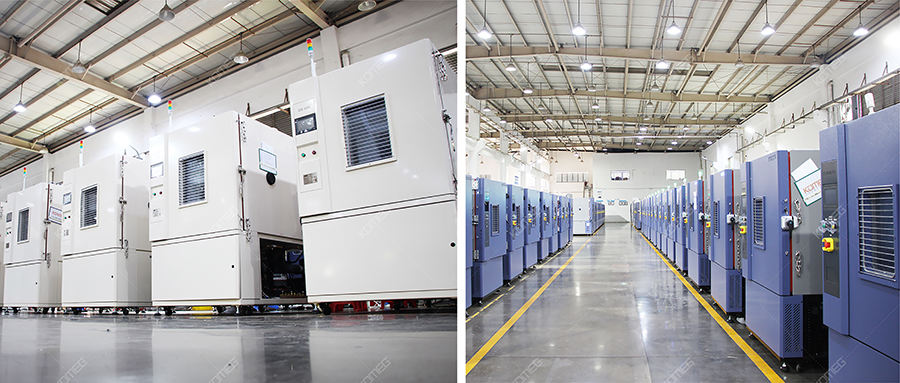Reliability industry is considered as the most promising industry in the 21st century. Reliability originally meant the ability of a product to operate normally on demand. Now reliability has added more additional attributes, which span products, services, software or human activities. These characteristics now permeate all aspects of today's technology-intensive society.

Let's follow the word "reliability" to see the development process of reliability from early to present.
1950s
China began to carry out reliability education in the first five-year plan since 1953, and the development of modern reliability in China started from this.
During the first five-year plan, an experimental research base for reliability and environmental adaptability was established to investigate and count the use and failure of electronic and some mechanical products, and to carry out environmental adaptability tests for product reliability.
At the same time, reliability laboratories have been set up in some research institutes and factories to carry out environmental adaptability and life test in the process of research, design and trial production of new products.
During the second and third five-year plans, a large number of research and test work on product reliability and environmental adaptability were carried out, and physical and chemical analysis of failed products was carried out. Based on the analysis of product failure mechanism, corresponding measures are taken in many aspects such as raw materials, product design, process and technical management to improve product reliability.
In the 1950s, a subtropical environmental adaptability test base was prepared and built in Guangzhou, which was engaged in environmental testing of electronic products and research on tropical protection measures.
In 1955, the environmental test work was officially started. First, natural exposure test stations were established in Guangzhou, Shanghai and Hainan, and the impact of tropical, subtropical and industrial gases on electronic and electrical products was explored in cooperation with six countries in Eastern Europe.
On December 23, 1955, according to the agreement on scientific and technological cooperation between China and Hungary, the Second Ministry of Machinery Industry approved the establishment of the "China Subtropical Telecommunications Equipment Research Institute".
In the late 1950s and early 1960s, there were reports on foreign reliability work in the internal journals of the former Ministry of Mechanical and Electronic Industry.
1960s
In the 1960s, China raised reliability problems in radar, communication machine and electronic computer, and began to take measures.
In the early 1960s, the Ministry of Electronics established the "China Institute of Reliability and Environmental Testing of Electronic Products" to carry out the pioneering work of reliability evaluation.
On September 10, 1960, the launch test station operated independently with domestic propellant for the first time, and successfully launched a Soviet short-range surface-to-surface missile.
On November 5, 1960, the Dongfeng-1 short-range ballistic missile copied by China from the Soviet Union was successfully tested for the first time.
On October 16, 1964, China's first atomic bomb exploded successfully.
In 1965, at the suggestion of the scientist Qian Xuesen, the Reliability and Quality Management Research Institute was established in the 7th Engine Department. Aerospace products adopt strictly selected "seven special" components.
Seven specialized products are seven specialized products: products made by special person, special machine, special material, special batch, special inspection, special technology, special card or special line.
In order to ensure the quality of military components, China has formulated a series of component standards. The "Seven Specialties" 7905 technical agreement formulated in the late 1970s and the "Seven Specialties" 8406 technical conditions formulated in the early 1980s. The "Seven Specialties" technical conditions are the basis for the establishment of China's military component standards. At present, the components produced under the "Seven Specialties" conditions or their strict conditions are still the main varieties used by aerospace and other departments.
When "two bombs and one satellite" was adopted, Premier Zhou put forward a 16-word policy: "serious, careful, safe, reliable and infallible", and took measures on the reliability design of the whole system to ensure the successful continuous launch of carrier rockets and communication satellites and the long-term normal operation of submarine communication cables.
In the military field, quantitative reliability requirements are put forward for some models and large systems. For this purpose, reliability allocation and prediction work as well as reliability evaluation and analysis in the design process are carried out to ensure the continuous improvement of product reliability.
At 8:20 a.m. on June 17, 1967, China's first hydrogen bomb explosion test was completely successful over Lop Nur, Xinjiang, in the western region of China.
In 1968, China's self-designed and constructed Nanjing Yangtze River Bridge was completed and opened to traffic.
On September 21, 1969, Mao Zedong inspected the Nanjing Yangtze River Bridge.
On September 26, 1969, Xu Shiyou commanded 80 domestic light tanks and more than 60 vehicles of various types to pass the Nanjing Yangtze River Bridge and test the Nanjing Yangtze River Bridge.
1970s
On April 24, 1970, China's first man-made earth satellite "Dongfanghong-1" was successfully launched.
In August 1970, the simulation test of submarine-launched missile was carried out using the Nanjing Yangtze River Bridge.
In the early 1970s, the aerospace department first proposed that electronic components must be strictly screened.
The Institute for Reliability and Environmental Testing of Electronic Products was established in 1972, which has played a positive role in promoting China's reliability engineering.
In the 1970s, China introduced foreign standard data. In 1972, the Standardization Institute of the Ministry of Electronics organized a group of scholars to collect and analyze foreign data, and started the reliability engineering of the 300-channel underground cable communication system. Two years later, the results were achieved.
In the 1970s, due to the need of key projects in China and the strong demand of consumers, it played a huge role in promoting the research of reliability in various industries;
In the 1970s, due to the urgent need of national key projects, especially the need for highly reliable components of aerospace and China-Japan submarine cables, the development of "seven specialized" products for electronic components and the verification test of components promoted the development of reliability mathematics in China.
In the mid-1970s, due to the need of Sino-Japanese submarine cables, the Ministry of Electronics carried out a highly reliable component verification test and developed it into an accelerated life test technology.
In the mid-1970s, due to the needs of the Sino-Japanese submarine cable project, the research on the verification test of high reliability components was put forward to promote the development of reliability mathematics in China.
Since 1973, the former Commission of Science and Technology for National Defense and the former Ministry of Machinery and Technology of the People's Republic of China have held several working meetings on improving reliability in order to solve the problem of reliability of components in key national projects.
Since 1973, the former National Defense Science and Technology Commission and the Fourth Machinery Department have held a series of reliability working meetings, and put forward to focus on studying and solving the reliability problems of components used in national key projects.

Since the late 1970s, many universities have held reliability courses to train in-service personnel. Later, reliability courses have been offered to recruit undergraduate and graduate students.
The first reliability standard SJ1044-76 Reliability Terminology was issued in 1976, which is the predecessor of the national standard GB3187-82 Basic Terms and Definitions of Reliability.
In 1978, the first reliability test method series standard SJ1432 ~ 1435-78 Life Test and Accelerated Life Test was issued and developed. The current national standard number is GB2689-81. GB1977-79 Test Method for Failure Efficiency of Electronic Components is the first national reliability standard issued. It has caused great changes in the quality indicators, inspection methods, quality assurance and other contents of electronic component product standards.
In 1978, the plan of "Seven Specialties" for Quality Control and Feedback Science Experiment of Electronic Product Reliability was put forward and implemented.
Since 1978, the former State Planning Commission, the Ministry of Electronic Industry and the General Administration of Radio and Television Industry have successively held working meetings on improving the quality of television sets, clearly put forward the reliability, safety requirements and reliability indicators for television sets and other products, and organized the national complete machine and component manufacturers to carry out large-scale overall quality management focusing on reliability.
Within five years, the MTBF of TV has been increased by one order of magnitude, the MTBF has been increased from 300 hours to 3000 hours, and the reliability of supporting components has also been improved by one or two orders of magnitude. As we have paid close attention to the reliability of national key projects and television sets, we have promoted the reliability of the whole machine and electronic components.
From the end of 1970s to the beginning of 1980s, the first climax of reliability work in China was formed. All industrial departments and arms of the country carried out reliability popularization training and education in succession, formed a backbone team, established a reliability work organization and management organization, and carried out reliability test and reliability design as well as information collection and feedback.

1980s
In the early 1980s, a large number of monographs on reliability work were published, the state formulated a number of standards for reliability work, and a large number of human resources were invested in reliability research by schools.
In the 1980s, various reliability institutions and academic groups in China developed rapidly. The first academic group established was the "National Professional Committee on Reliability and Quality Management of Electronic Products" under the China Electronics Association. Then the "Reliability Mathematics Professional Committee" was established in 1981, and then corresponding reliability academic groups were established in aviation, aerospace, instrumentation and other disciplines.
In order to facilitate the coordination of work with the International Electrotechnical Commission's Technical Committee on Reliability Standards (IEC/TC 56), the "National Technical Committee on Electrotechnical Reliability and Maintainability Standardization" was established in August 1982 to undertake the review and consultation of basic standards for electrotechnical reliability.
At 15:00 on October 12, 1982, China's Julang-1 submarine-launched missile was successfully launched for the first time.
Since 1984, the organization has formulated, introduced and issued reliability and infinitesimal standards, forming a relatively complete system. Military enterprises have carried out the work of making up lessons on reliability and product reliability growth, and the military has carried out the work of reliability evaluation and analysis.
Since 1984, under the unified leadership of the Commission of Science, Technology and Industry for National Defense, a series of basic regulations and standards on reliability have been formulated in combination with China's national conditions and actively absorbing foreign advanced technologies.
The Interim Provisions on the Life and Reliability of Aviation Technology and Equipment issued by the National Defense Science, Technology and Industry Commission in October 1985 is a sign that the reliability engineering of China's aviation industry has fully entered the stage of engineering practice and system development.

In May 1987, the State Council and the Central Military Commission issued the "Regulations on the Quality Management of Military Products", which made it clear that reliability technology should be used in product development.
The national military standards GJB368-87 General Specification for Equipment Maintainability and GJB450-88 General Outline for Reliability of Equipment Development and Production issued successively in December 1987 and March 1988 can be said to be the representative basic standards for the reliability technology of military products in China at present.
At the end of the 1980s, leaders at all levels changed their concepts and attached importance to product quality. First, they strengthened the quality and reliability of weapons and equipment, and vigorously implemented the Regulations on the Quality Management of Military Products. The regulations on the quality management of military products clearly put forward the requirements for reliability work, mainly implementing the Reliability Assurance Program in the development stage and the Quality Assurance Program in the production stage.
By publicizing and implementing GJB450 "Regulations on Reliability and Maintainability Management of Equipment Development and Production", the second climax of China's reliability work was set off in the late 1980s and early 1990s.
1990s
At the beginning of the 1990s, China's former Ministry of Machinery and Electronics Industry put forward the concept of "taking science and technology as the guide and quality as the main line", and carried out reliability work along the development mode of "managing, controlling well and improving the level", which rose the second climax of China's reliability work and made great achievements.
Since the 1990s, due to the more prominent importance of software reliability issues and the continuous expansion of the scope of software reliability engineering practice, software reliability has gradually become an important factor to be considered by software developers. Software reliability engineering has gradually gained a relatively independent position in the field of software engineering and has become a vibrant branch.
At the beginning of the 1990s, it fell into a low ebb. Few people worked in this field and the academic achievements were mediocre. The main reason is that the reliability work is difficult to do and the results are slow.
In recent years, the reliability work has been heated up. The power of this warming up is mainly due to the importance of enterprises on product quality, which tends to be rational. Many industrial departments have placed reliability work in an important position, and the Military Industry Group has successively established the Group's reliability center.
For example, the Weapons Reliability Center was established in 1991. On this basis, the National Defense Science and Technology Industrial Machinery Reliability Research Center was established in 2008. At present, a series of reliability technology achievements with completely independent intellectual property rights have been continuously promoted and applied.
Throughout the 20th century, China's pioneering work from scratch, marked by atomic bombs, hydrogen bombs, missiles, satellites, and submarine-launched missiles, has not only consolidated national defense, but also established the image of a big country. At the same time, it also shows that China's defense industry manufacturing reliability has reached an unprecedented level in these cutting-edge scientific and technological fields.








